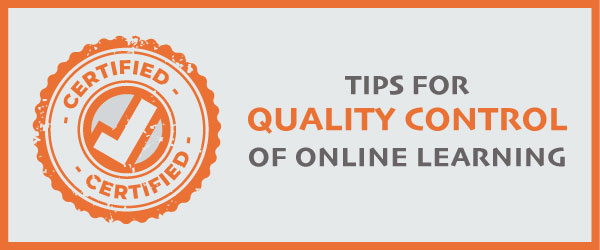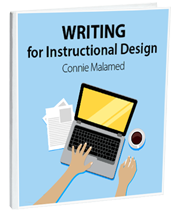
Have you ever been humiliated by your client finding an obvious error in a program that’s already been released? The troubleshooting, re-testing and scrambling to fix the problem can turn into a heart-pounding race against the clock. Not that this ever happened to me, of course, but a friend told me this can happen. What was missing in this situation was the quality control (QC) process.
Our best defense against these high-risk scenarios is to conduct thorough and systematic quality control testing of online learning before any deliverable is released. Although QC and testing are related terms, they refer to different procedures. Compare the definitions below. This article focuses on quality control.
- Quality Control: refers to the processes that determine whether a completed deliverable or product meets a set of quality criteria or requirements.
- Testing: refers to the processes that ensure there are no technical issues and is based on a test plan designed ahead of time.
QC evaluations are needed before any deliverable is sent to clients or stakeholders for review, prior to a formative evaluation by target audience members, as well as before a formal course is released. But quality control of online learning need not imply that the learning experience is traditional. Rather, you can use this approach any time content is getting designed and produced.
Benefits of Quality Control for Online Learning
Not only does the quality control review create a more professional product, it improves the experience and usability of the learning experience. Usability—the extent to which a product can be used to achieve specific goals with ease and satisfaction—is an important affective component of learning. High usability can improve motivation. It prevents learner frustration and confusion. All of this can make information easier to process.
QC for Online Learning: Steps to Follow
- Plan Ahead: Plan the quality standards ahead of time rather than when the pressures of a tight schedule force you to take shortcuts.
- Be Holistic: As you develop the criteria, think about all the standards the product must meet, including editorial, appearance, usability and instructional approach.
- Create Checklists: Use checklists for standardization, efficiency and accuracy.
- Create Review Forms: Use online QC forms to log every issue that fails review. Use an identification number for each issue and ensure that each one is addressed prior to logging it as “Fixed.”
- Be Consistent: Use the same QC standards across all projects and across similar media (see below for some examples).
- Schedule It. Reserve time in the schedule for QC review. It can take 10% to 15% of a project’s time for QC and testing.
- Get QC Training: Unless your organization is large enough to have a QC team, train instructional designers, graphic designers and media specialists in QC skills. They can lead the way, set up systems and train others.
- Use Fresh Eyes: Use someone removed from the project to perform a QC review. People have difficulty finding all the errors in their own work.
Continually improve your QC processes and criteria as you learn from your mistakes. - Document It: Write up your QC process. Revise it as you continue to learn what works for your organization.
- Debrief: QC logs potentially hold a wealth of information. Use them at the end of a project to understand where the weaknesses are in your systems and try to fix them.
Example Standards for Online Learning Quality Control
Editorial
Editorial standards include those used for any documents.
- Documents are edited for clarity.
- Documents are spell-checked and reviewed for spelling errors not caught by spell-checkers.
- Documents are reviewed for punctuation and grammar.
- Documents are checked for consistency in terminology and language.
Media
- Audio volume levels are consistent.
- Video is of consistent quality.
- Synchronize text, graphics and audio.
Appearance
The quality control review of appearance often relates to visual consistency. This is an excellent reason to develop a visual style guide. Standards might include:
- Developers are using eLearning templates consistently.
- There is consistency in font selection across all screens or slides.
- Image captions are consistent and accurate.
- Colors and types of highlights and arrows are consistent.
- The product matches the storyboards.
Usability
Test and revise the usability of your product early in development. By getting this out of the way, quality reviewers will only need to review for consistency in the user interface, navigation and similar aspects. For example:
- Navigation instructions are clear and consistent.
- Menus are consistent across modules.
- User interface supports learning.
- Interactions are easy to understand and use.
- Access to social media platforms is smooth.
- The program meets accessibility standards.
Instructional Approach
There are certain features in the instructional approach that QC reviewers can evaluate. These are:
- There is no extraneous content.
- Instructional strategies support learning that will transfer to the real world.
- Interactions facilitate and guide meaningful learning.
- Instructional feedback supports the task the learner is performing.
To summarize, when you implement quality control of online learning, you create the standards that make sense for the learners and their environment as well as the content. Then evaluate the online learning experiences against these criteria.


Hi Sandra,
So happy this was helpful. Hope to hear your added perspective on things in the Comments sometime!
Regards,
Connie
You have no idea how helpful this has been…just this past week I was asked to provide samples on elearning course testing and I was stumped so this has been an answer to prayer – seriously! Thank you…feel free to provide more and send to my personal email: srosputko@gmail.com….
Serioulsy is there anyting you don’t provide on your website – it’s so awesome Connie! Thanks again.